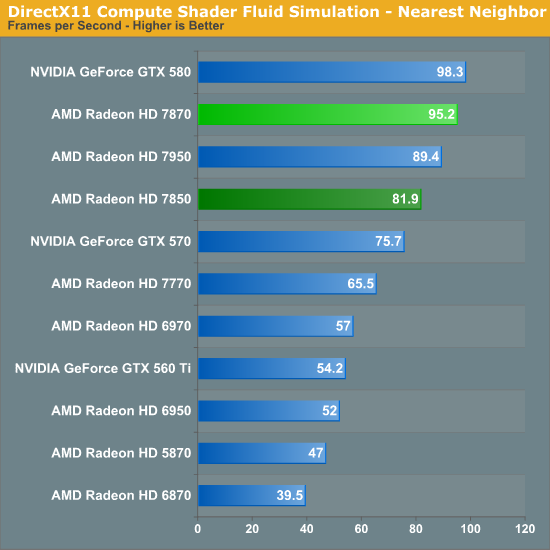AMD Radeon HD 7870 GHz Edition & Radeon HD 7850 Review: Rounding Out Southern Islands
by Ryan Smith on March 5, 2012 12:01 AM ESTCompute Performance
Moving on from our look at gaming performance, we have our customary look at compute performance. With GCN AMD significantly overhauled their architecture in order to improve compute performance, as their long-run initiatives rely on GPU compute performance becoming far more important than it is today.
Our first compute benchmark comes from Civilization V, which uses DirectCompute to decompress textures on the fly. Civ V includes a sub-benchmark that exclusively tests the speed of their texture decompression algorithm by repeatedly decompressing the textures required for one of the game’s leader scenes. Note that this is a DX11 DirectCompute benchmark.

The Civ V compute shader benchmark once again shows off just how much the compute shader performance of the 7800 series has improved relative to the 6900 series, with both 7800 cards coming in well, well ahead of any previous generation AMD cards. Compared to NVIDIA’s lineup the 7800 series does fairly well for itself too, although not quite as well as the commanding lead the 7900 series took.
Our next benchmark is SmallLuxGPU, the GPU ray tracing branch of the open source LuxRender renderer. We’re now using a development build from the version 2.0 branch, and we’ve moved on to a more complex scene that hopefully will provide a greater challenge to our GPUs.

SmallLuxGPU continues to showcase the 7800 series’ improvements over past AMD architectures, and while it’s not the same kind of massive leap we saw with CivV, it’s still enough to bring the 7850 up to near the performance of the 6970, and pushing the 7870 well beyond that. The only real competition here for AMD is AMD.
For our next benchmark we’re looking at AESEncryptDecrypt, an OpenCL AES encryption routine that AES encrypts/decrypts an 8K x 8K pixel square image file. The results of this benchmark are the average time to encrypt the image over a number of iterations of the AES cypher.

On the one hand, the 7870 gets quite close to the 7950 here in our AESEncryptDecrypt benchmark, in spite of the latter’s higher number of shaders. On the other hand, it’s still not enough to dethrone the GTX 570; the only NVIDIA cards the 7800 series can beat start at the GTX 560 Ti.
Finally, our last benchmark is once again looking at compute shader performance, this time through the Fluid simulation sample in the DirectX SDK. This program simulates the motion and interactions of a 16k particle fluid using a compute shader, with a choice of several different algorithms. In this case we’re using an (O)n^2 nearest neighbor method that is optimized by using shared memory to cache data.

In our final compute test the 7800 series once again makes a run at the top, with both cards rising past the GTX 570, although they can’t quite match the GTX 580. In an interesting turn of events the 7870 ends up being some 6% faster than the 7950, in spite of the fact that in a compute benchmark the 7950 should have a solid lead. This just goes to show that core clockspeeds do matter, and that adding more shaders alone can’t conquer all benchmarks.










173 Comments
View All Comments
Ryan Smith - Monday, March 5, 2012 - link
Whoops, flipped a number. Thanks!Dark_Archonis - Monday, March 5, 2012 - link
Good to see AMD providing tough competition for Nvidia.Now, when do we see Kepler? Nvidia has been taking their sweet ass time with Kepler, it's frustrating. Fermi overall is a frustrating architecture, in that it's only fast in mid-high and high-end specifications. In mid-range and low-end cards Fermi sucks, when compared to equivalent AMD cards.
Well AT, how long do we have to wait for Kepler? I hope Kepler brings a big performance boost across the board for Nvidia. Intel will only keep improving their integrated graphics, so Nvidia's low and mid-range graphics offerings need to be MUCH better than they currently are, to be worth buying in the future. This is especially true in the laptop market.
Radnor - Monday, March 5, 2012 - link
Really for the exception of 7750 witch has a really low power draw, my i will stick with my 4850 CF for now. No reason for upgrade. I mean no new demanding games and 7xxxx ati cards are just expensive.Death666Angel - Monday, March 5, 2012 - link
"Once again the 7970 and 7950 place quite close to each other, particularly at 1920. "I think you mean 7870 and 7950? :-)
tech6 - Monday, March 5, 2012 - link
For those waiting for nVidea to come to the rescue with an amazing next generation product, I would urge you not to get your hopes up. Nvidea sees their future in the mobile space creating Tegra APUs and mobile graphics and this is where they are spending their R&D budget. The desktop graphics market is simply not growing much anymore.DeViLzzz - Monday, March 5, 2012 - link
some people care about Physx so we have to wait on Nvidia lolA5 - Monday, March 5, 2012 - link
Why? There's like 2 games that use it.CeriseCogburn - Thursday, March 8, 2012 - link
There's actually like 2 hundred, but keep drinking the radeonaide.SpaceRanger - Monday, March 5, 2012 - link
The lacking of WHQL Drivers has me shaking my head. Come on AMD. It's been 3 months and you STILL can't get a WHQL driver out for the 7xxx series!
DeViLzzz - Monday, March 5, 2012 - link
if you already have a 560 Ti I guess you hope for another price drop on the cards so you can SLI themif you can get your hands on an affordable used 6970 or a new Power Color 2 GB 6950 and flash it to a 6970 then do so